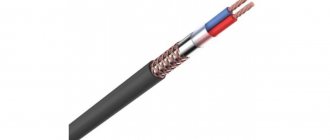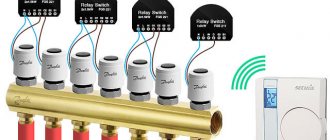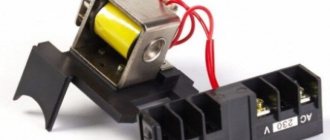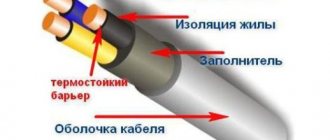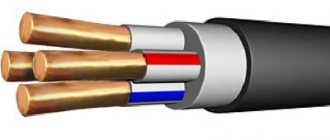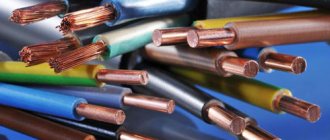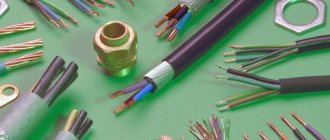NYM copper cable is a popular conductor used in the construction of internal wiring of residential and administrative buildings. It can be installed inside many other buildings, including mid-level fire-hazardous structures.
The product originally appeared in Europe, hence the Latin letters in the abbreviation. Today, the product is manufactured in many European countries and in several Russian factories. Cable products from Sevkabel and Pskovkabel are in no way inferior in quality to imported NYM products.
Application area
NYM cable can be used in various climatic zones, inside production facilities with low or high humidity levels, in domestic and living rooms and even outdoors. When installing outdoors, it is important to avoid direct exposure to ultraviolet rays of the sun.
Inside residential buildings, wire is used in different cases: both with open and hidden wiring. It is used to switch lighting equipment, electrical sockets, switches and other devices. When installing a line in open ground, the cable must be protected using corrugated pipes or special boxes. When laid aerially, NYM is reinforced with high-quality overpasses. For any electrical devices that require a seal at the input, it is best to use just such a cable.
Residential use
People often wonder, is it possible to use a simple VVGng, without the LS index? The rules, which have changed significantly in recent years, say that for installation inside residential premises, simple VVGng is prohibited.
This brand can only be used outside the building. See GOST 31565-2012 –.
This is explained by the fact that although it does not burn, under the influence of a flame it releases a huge amount of toxic substances. But it is because of combustion products, and not from fire, that most people die in fires.
Explanation of the abbreviation NYM
The Latin abbreviation NYM stands for the following:
- N – standard type cable (German gradation);
- Y – the insulating sheath of the cores is made of polyvinyl chloride (PVC);
- M – with outer shell.
As usual, the absence of the letter “A” in the first place indicates that the cable cores are made of copper. In addition to the three standard letters in the designation, J or O can be added through a hyphen - with or without a yellow-green conductor (ground conductor).
After the alphabetic symbols there are necessarily digital symbols, indicating the number of cores and the cross-section of each of them. For example, the product NYM-O 4×4.5 - 0.66 can be deciphered as follows:
- standard cable with polyvinyl chloride core insulation and outer sheath;
- consists of four cores with a cross-sectional area of 4.5 square meters. mm each;
- used at voltages up to 0.66 kV (660 V).
Color coding
Such a cable must be produced with standardized color markings. The absence of this indicates that the product is not certified and is a counterfeit. The standards for the color of conductors are prescribed in the rules for electrical installations (PUE).
The set of colors varies depending on the exact number of cores located inside the outer sheath:
- there are no regulations for single-core cables;
- two conductors without a grounding cable - black and blue conductors;
- three cores without a grounding cable - black, brown and gray;
- four cores without a grounding cable - black, brown, gray and blue;
- three cores with a grounding cable - black, blue and yellow-green;
- four cores with a grounding cable - black, brown, gray and yellow-green;
- five cores with a grounding cable - black, brown, grey, blue and yellow-green.
Depending on the color marking, specialists can easily determine the main purpose of the cable. The blue wire is usually used to connect the neutral wire in single-phase networks. In three-phase, the blue core acts as a neutral. The yellow-green conductor in all cases serves as a grounding conductor.
Important! In accordance with GOST, the NYM cable should not contain conductors with white or white-blue insulation. If there is one, the conclusion is simple - it is a fake. Further use of such products, if possible, is at your own peril and risk.
NYM-J cable design elements:
- Core: single-wire or multi-wire copper conductor.
- Insulation: polyvinyl chloride (PVC) plastic compound.
| 1 | Number of cores | NUM-J NUM-O |
| 2 | – | Black, blue |
| 3 | Green-yellow, black, blue | Black, blue, brown |
| 4 | Green-yellow, black, blue, brown | Black, blue, brown, black |
| 5 | Green-yellow, black, blue, brown, black | Black, blue, brown, black, black |
- Internal filling: unvulcanized rubber, highly filled plastic compound or thermoplastic elastomer.
- Outer shell: polyvinyl chloride plastic compound in grey, black or white.
The NYM-J cable uses internal filling made of unvulcanized rubber, highly filled plastic compound or thermoplastic elastomer, which:
- * prevents the risk of cracking during operation in unfavorable conditions,
- * allows you to easily and conveniently “cut” the cable during installation,
- * increases cable flexibility,
- *gives the cable a round shape.
Design features
Domestic manufacturers produce several modifications of the NYM cable. Some of them are designed in full compliance with German standards and requirements (VDE), others are designed according to customer specifications. In most cases, each plant uses its own developments, prescribed in the technical specifications, and the cable can be called differently - from NUM or NUM to NUM. This suggests that there is no strict general standard here. As a result, you can buy what appears to be NYM on the market, but in fact purchase domestic analogues, the technical and operational characteristics of which differ significantly from German standards.
An example of inconsistencies include leaks of the compound used when filling the free space between the cores. German engineers require the use of a compound made of chalk-filled rubber, but the specifications of domestic manufacturers may indicate a different material characterized by less strength and a weak thermal coefficient. This leads to the appearance of various leaks.
The NYM wire can use a monolithic core structure, the cross-sectional area of which should not exceed 10 square meters. mm or stranded. Many people mistakenly call a multi-core cable, but in reality we are talking about the structure of one specific core. The cross-section of stranded conductors is in the range of 16-35 square meters. mm.
Thus, the NYM cable consists of several copper cores insulated with polyvinyl chloride plastic. All conductors are covered with a non-flammable layer, on top of which an external insulation made of polyvinyl chloride is placed. In accordance with GOST, each wire has a specific color marking.
Design
This wire can only have copper conductors (for comparison, European standards imply the use of copper for cable products “by default”; aluminum wires are marked with the letter “A”). The cross-sectional shape is always round.
Thin, up to 10 mm square, conductors are single-core wire, starting from 16 mm - multi-core twisted. The insulation of the conductors is made, as follows from the designation, from polyvinyl chloride. Next comes a fairly dense and thick shell of a rubber mixture, which contains chalk, enveloping all the internal wires. The outer shell is durable PVC-based plastic.
The layer between two layers of insulation (usually white) serves to give the wire a regular round shape, as well as increase its flexibility and ease of cutting.
Specifications
Let us briefly list all the technical and operational parameters of NYM:
- number of cores - from two to five;
- maximum permissible voltage - 660 V at an alternating current frequency of 50 Hz;
- flexible cable;
- no need to heat up during installation;
- The gasket is permissible at a minimum temperature of -5 degrees. Celsius;
- operating temperature range from -50 to +50 degrees. Celsius;
- service life – 40 years;
- permissible bending radius - four outer diameters;
- Resistant to open fire, does not spread fire.
Advantages and disadvantages
Among many conductors, NYM cable is considered to be the “golden mean”. To better understand its quality, let’s consider the main advantages of this product:
- Increased elasticity, ease of installation and operation. This flexibility is due to the presence of an internal insulating layer of rubber. This advantage is very important when performing any installation work on electrical wiring, as well as when installing equipment in inaccessible or hard-to-reach places. The wire is not affected by dampness and moisture, so it can be laid along the ground over long distances.
- If we talk about NYM, manufactured according to German quality standards, then before entering the market it must undergo numerous studies and tests. The Germans have long earned the title of the most reliable and high-quality manufacturers of industrial and other products, so there is no doubt about the integrity of the insulation and the compliance of the cable with all the declared technical and operational properties.
- The product does not support combustion, which was made possible due to the choice of material for the inner layer.
- Most specialists and electricians recommend using the product to connect lighting systems and power circuits.
- Long service life spanning several decades.
The most obvious disadvantage of NYM cable is its high cost. There are many domestic analogues, albeit with worse characteristics, the prices of which are several times lower.
What errors occur when using NYM cable
NYM wire is mainly recommended for installation work in buildings in the construction of which wood or flammable materials were used.
It must be remembered that the wire does not spread fire only when individually laid. If you need to use a group gasket, then it is advisable to purchase products from other brands that are intended for this type of work.
Many people are faced with the problem of laying wires in baths, saunas or steam rooms. It is allowed to install this wire in such premises. Because the rubber layer fits tightly to the wire insulation, thereby preventing moisture from penetrating into the cable. These are the only problems that may arise when using the product.
What is the difference between NYM and VVGng
The NYM cable will be useful only for single installations. If you are planning a group session, then it is better to make a choice in favor of VVG. Structurally, both products consist of several copper cores with polyvinyl chloride insulation and the same outer shell. However, only VVGng (the prefix “ng” indicates the non-flammability of the cable) is able to stop the flame and prevent its spread during group installation of several conductors.
We list the main technical and operational characteristics of NYM and VVGng and compare them in the table below:
| Characteristic | NYM | VVGng |
| Allowable voltage | 660 V | 660 V |
| Current frequency | 50 Hz | 50 Hz |
| Number of cores | 2-5 pcs. | 1-5 pcs. |
| Cross-sectional area of one core | 1.5-35 sq. mm | 1.5-240 sq. mm |
| Lifetime | 40 years | 30 years |
| Filling empty space | Present | Absent |
| Does not support fire spread | Single gasket only | Any gasket, including group gasket |
| Possibility of operation in difficult conditions | Moisture protection, not UV resistant | Can be used in any situation |
Manufacturers NYM
NYM cable is produced at foreign and domestic enterprises. The most popular factories in our country are:
- "Sevkabel";
- "Technoton";
- "Concord";
- "Pskovkabel";
- "Kamkabel".
Any products of these enterprises undergo all necessary stages of certification in accordance with international quality standards. For foreign companies, we will highlight the German TKD Kabel, Lapp Kabel and Helukabel, the French Nexans and the Turkish Denizli Cable.
NYM is stored and transported in special coils or drums, the diameter of which can be eight times the thickness of the cable itself. During storage, it is better to use a hard-to-reach and closed place, the minimum temperature of which is not lower than -15 degrees. Celsius. Also be sure to avoid direct exposure to direct sunlight.
Cable laying features
Despite the fact that the technical documentation states that the NYM wire is non-flammable, it would be a mistake to believe that it is absolutely not susceptible to fire. The main condition for non-flammability is the absence of bundles and other cables laid nearby.
Another feature of this brand of cable is its sensitivity to ultraviolet radiation, so it cannot be used in open spaces. On the other hand, the above VVGng has identical parameters and a much wider scope of application. It is suitable for both indoor and outdoor installations. VVGng can be safely used to enter an electric line from a pole to a house or when arranging a branch directly behind the SIP wire.
That is why many experts consider VVGng an improved analogue of the NYM cable. The foreign analogue is considered to be the MMJ wire, which is devoid of the above disadvantage. This is what is used for external installation.
Cable VVGng and VVGng-LS differences
The first most common and most correct cable option is VVGng and its variety VVGng-LS. The cable has the following design:
It can be single-core or multi-core. In this case, the conductor was single-wire up to a cross-section of 25mm2. Most often it has a flat shape, which is very convenient when placing it in a narrow groove in a vertical position.
And in plastic cable channels it is convenient to lay wires of this particular shape. At the same time, do not forget that there should still be 40% free space in the cable channel after installation.
Tips for choosing
When going to the market for such a cable, be careful, since most of the products that sellers call the domestic analogue of NYM wire are fake. This is evidenced by the lack of necessary markings. When choosing a cable, pay attention to the logo and markings shown. Reliable and trusted manufacturers always put their own markings on the product. This already provides some kind of guarantee that the manufacturer is not afraid to bear responsibility for the products produced and is confident in their quality.
Sales consultants or ordinary market traders may recommend that you purchase SHVVP or PVS wires, stating that they are an excellent analogue of the NYM cable. You should not fall for such tricks, since in the case of SHVVP and PVS we are talking about ordinary cords. The main characteristic that distinguishes a cord from a cable product is related to its operational capabilities. The first is often suitable exclusively for switching household appliances and equipment, and the second is for connecting all wiring and more complex equipment.
Be sure to choose a cable with a grounding, yellow-green conductor, which will allow you to ensure high safety when operating equipment and home wiring. When choosing a product cross-section, you need to be guided by simple and general rules. When connecting lighting systems, it is enough to use wires with a cross-section of 1.5 square meters. mm, socket or switches - 2.5, oven or electric oven - from 4.5 sq. mm.
Despite the numerous domestic factories that are trying to produce high-quality NYM cable, in this case it is best to give preference to foreign factories from Germany, France or Turkey. Who knows, perhaps in a few years the situation will change, but for now we are forced to state this sad fact. In terms of operation, NYM is only suitable for internal single gasket applications. The product does not support any other options: you should not be fooled by the persuasion and deception of sellers!
